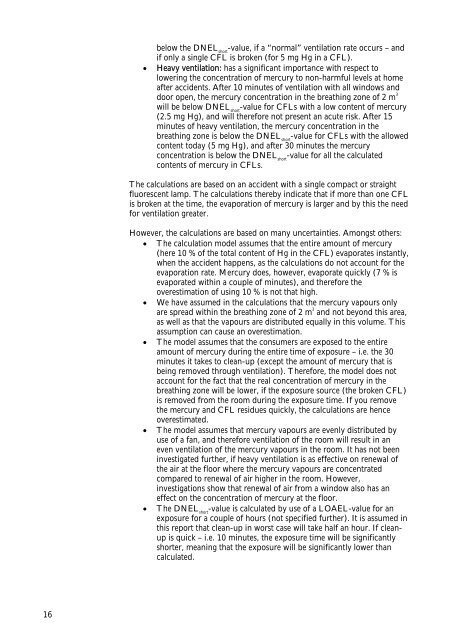Kortlægning og sundhedsmæssig vurdering af ... - Miljøstyrelsen
Kortlægning og sundhedsmæssig vurdering af ... - Miljøstyrelsen
Kortlægning og sundhedsmæssig vurdering af ... - Miljøstyrelsen
Create successful ePaper yourself
Turn your PDF publications into a flip-book with our unique Google optimized e-Paper software.
16<br />
below the DNEL short -value, if a “normal” ventilation rate occurs – and<br />
if only a single CFL is broken (for 5 mg Hg in a CFL).<br />
Heavy ventilation: has a significant importance with respect to<br />
lowering the concentration of mercury to non-harmful levels at home<br />
<strong>af</strong>ter accidents. After 10 minutes of ventilation with all windows and<br />
door open, the mercury concentration in the breathing zone of 2 m 3<br />
will be below DNEL short -value for CFLs with a low content of mercury<br />
(2.5 mg Hg), and will therefore not present an acute risk. After 15<br />
minutes of heavy ventilation, the mercury concentration in the<br />
breathing zone is below the DNEL short -value for CFLs with the allowed<br />
content today (5 mg Hg), and <strong>af</strong>ter 30 minutes the mercury<br />
concentration is below the DNEL short -value for all the calculated<br />
contents of mercury in CFLs.<br />
The calculations are based on an accident with a single compact or straight<br />
fluorescent lamp. The calculations thereby indicate that if more than one CFL<br />
is broken at the time, the evaporation of mercury is larger and by this the need<br />
for ventilation greater.<br />
However, the calculations are based on many uncertainties. Amongst others:<br />
The calculation model assumes that the entire amount of mercury<br />
(here 10 % of the total content of Hg in the CFL) evaporates instantly,<br />
when the accident happens, as the calculations do not account for the<br />
evaporation rate. Mercury does, however, evaporate quickly (7 % is<br />
evaporated within a couple of minutes), and therefore the<br />
overestimation of using 10 % is not that high.<br />
We have assumed in the calculations that the mercury vapours only<br />
are spread within the breathing zone of 2 m 3 and not beyond this area,<br />
as well as that the vapours are distributed equally in this volume. This<br />
assumption can cause an overestimation.<br />
The model assumes that the consumers are exposed to the entire<br />
amount of mercury during the entire time of exposure – i.e. the 30<br />
minutes it takes to clean-up (except the amount of mercury that is<br />
being removed through ventilation). Therefore, the model does not<br />
account for the fact that the real concentration of mercury in the<br />
breathing zone will be lower, if the exposure source (the broken CFL)<br />
is removed from the room during the exposure time. If you remove<br />
the mercury and CFL residues quickly, the calculations are hence<br />
overestimated.<br />
The model assumes that mercury vapours are evenly distributed by<br />
use of a fan, and therefore ventilation of the room will result in an<br />
even ventilation of the mercury vapours in the room. It has not been<br />
investigated further, if heavy ventilation is as effective on renewal of<br />
the air at the floor where the mercury vapours are concentrated<br />
compared to renewal of air higher in the room. However,<br />
investigations show that renewal of air from a window also has an<br />
effect on the concentration of mercury at the floor.<br />
The DNEL short -value is calculated by use of a LOAEL-value for an<br />
exposure for a couple of hours (not specified further). It is assumed in<br />
this report that clean-up in worst case will take half an hour. If cleanup<br />
is quick – i.e. 10 minutes, the exposure time will be significantly<br />
shorter, meaning that the exposure will be significantly lower than<br />
calculated.

















